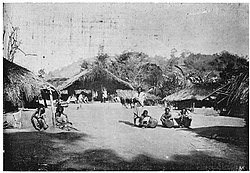Adi Dravida
Adi Dravida (or Adi Dravidar) is term used by the state of Tamil Nadu in India to denote Paraiyars since 1914.[3] Paraiyars are about 59% of the total Scheduled Caste population in Tamil Nadu. As they compromise most of that group the Tamil Nadu Government decided to refer to all people in the Scheduled Caste as Adi Dravidars. At the time of the 2011 Census of India, they made up about 18% of the state's population.[4]

| Regions with significant populations | |
|---|---|
| 1,29,86,465[1][2](estimated 2011) | |
| Languages | |
| Tamil | |
| Religion | |
| Hinduism, Buddhism, Jainism, Sikhism, Judaism, Islam, Christianity | |
| Related ethnic groups | |
| Paraiyar |
Origin
Iyothee Thass, a leader of the Paraiyar community, believed that the term "Paraiyar" was a slur. He attempted a reconstruction of Tamil history, arguing that the Paraiyars were the original inhabitants of the land, who had been subjugated by upper-caste invaders. Another Paraiyar leader, Rettamalai Srinivasan, however, advocated using the term "Paraiyar" with pride, and formed the Parayar Mahajana Sabha ("Paraiyar Mahajana Assembly") in 1892.[5] Thass, on the other hand, advocated the term "Adi-Dravida" ("Original Dravidians") to describe the community. In 1892, he used the term Adidravida Jana Sabhai to describe an organisation, which was probably Srinivasan's Parayar Mahajana Sabha. In 1895, he established the "People’s Assembly of Urdravidians" (Adidravida Jana Sabha), which probably split off from Srinivasan's organisation. According to Michael Bergunder, Thass was thus the first person to introduce the concept of "Adi Dravida" into political discussion.[3]
In 1918, the Adi Dravida Mahajan Sabha also requested the Indian government use the term to replace the current but pejorative term "Pariah" (Paraiyar) used for the community.[6]
Another Paraiyar leader, M C Rajah — a Madras councillor — made successful efforts for adoption of the term "Adi-Dravidar" in the government records.[5] In 1914, the Madras Legislative Council passed a resolution that officially censured the usage of the term "Paraiyar" to refer to a specific community, and recommended "Adi Dravidar" as an alternative.[7] In the 1920s and 1930s. E. V. Ramasami ensured the wider dissemination of the term "Adi Dravida".[3]
References
Citations
- "Half of India's dalit population lives in 4 states". The Times of India. 2 May 2013. Retrieved 12 February 2018.
- "Census of india 2011" (PDF). Government of India.
- Bergunder 2004, p. 69.
- "Half of India's dalit population lives in 4 states". The Times of India. 2 May 2013. Retrieved 12 February 2018.
- Srikumar 2014, p. 357.
- Christophe Jaffrelot (2003). India's Silent Revolution: The Rise of the Lower Castes in North India. Columbia University Press. pp. 169–. ISBN 978-0-231-12786-8.
- Bergunder 2011, p. 260.
Bibliography
- Bergunder, Michael (2004), "Contested Past: Anti-brahmanical and Hindu nationalist reconstructions of early Indian history" (PDF), Historiographia Linguistica, 31 (1): 95–104, doi:10.1075/hl.31.1.05berCS1 maint: ref=harv (link)
- Bergunder, Michael (2011), Ritual, Caste, and Religion in Colonial South India, Primus, ISBN 978-93-80607-21-4
- Srikumar, S. (2014), Kolar Gold Field: (Unfolding the Untold), Partridge Publishing India, ISBN 978-1-4828-1507-8CS1 maint: ref=harv (link)